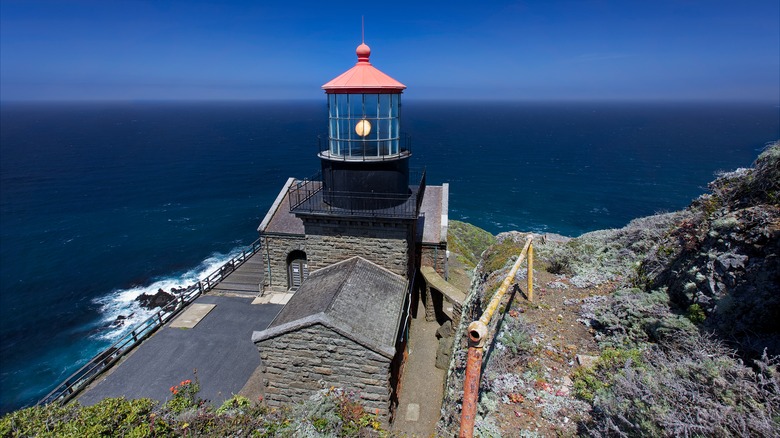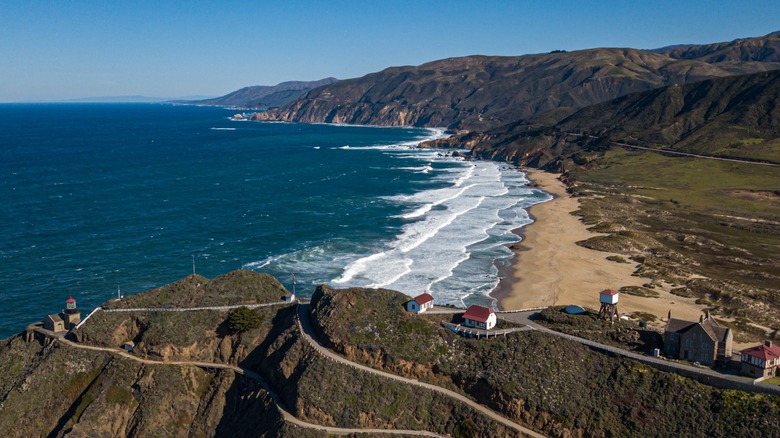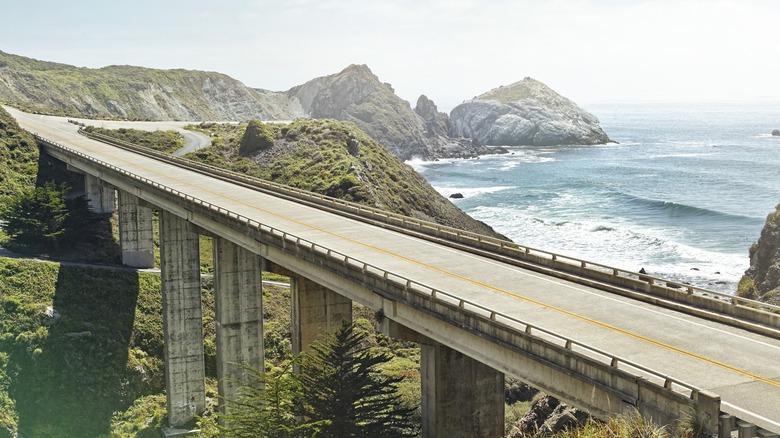This Unique California Lighthouse Is Rich With History And Considered A Big Sur Gem
To explore California's striking coast on a road trip, you'll want to head straight for Highway 1. The epic sweep of coastline between Santa Barbara to Monterey traverses through Big Sur, which has always been a favorite for outdoor-loving travelers in the state and beyond. The rocky environment provides challenges by land and sea (as this Big Sur beach with a horrifying nickname attests), so Point Sur is a lifesaver for ships that sail too close to the shoreline.
Since 1889, the Point Sur Lightstation has been mitigating dangerous fog atop the wild beauty of the peninsula, rising 361 feet above the Pacific. Until 1974, lighthouse keepers lived on Point Sur with their families full-time; today, the lights are automated and serviced by the U.S. Coast Guard. It's located about 21 miles south of the small coastal town Carmel-by-the-Sea.
On Saturdays, Sundays, and Wednesdays, you can take a three-hour, docent-led tour of the historic site. As the elevation rises and the wind picks up, you'll have to hike up two stairways, so wear layers and good walking shoes to stay comfortable and warm. Advance reservations are not accepted; the journeys are filled on a first-come, first-serve basis. In the summer, moonlight tours are offered on select Saturdays, and other special expeditions and events are held throughout the year.
Point Sur's iconic history
The area surrounding Point Sur was home to Native Americans for generations before the Portuguese and Spanish explored it in the 16th and 17th centuries. When California became a part of the U.S., the coast was examined for lighthouse sites to help naval navigation. The region's natural landscape made it hard for sailors to traverse the area, and after the Venture shipwreck of 1875, congress finally approved the construction of a lighthouse at Point Sur. A railway was also built to facilitate access to the top of the rock. Once the area was ready, the lighthouse keepers and ranch families schooled their children together and helped each other survive in the beautiful but inhospitable locale.
During the Cold War, naval facilities on Point Sur were used to detect Soviet submarines crossing the Pacific with a high-tech Sound Surveillance System (SOSUS). You can tour the ground-level structure to discover its top-secret mission and see how it works. Like the lighthouse tour, these guides are only available on a first-come, first-serve basis. Both tours are sometimes canceled in extreme weather conditions, so don't bother going on a blustery day.
You can catch some stunning views at the Point Sur State Historic Park surrounding the lighthouse. Off Highway 1, you can climb the crags and maybe even spot a humpback or blue whale in the Monterey Bay National Marine Sanctuary. The park is only open to visitors on guided tours of the light station or naval facilities. Dogs are not allowed at the park, either.
Road-tripping through Big Sur
The highway through Big Sur crosses bridges overlooking the ocean and creeps along winding mountainous passes. It is known as one of the most dangerous pathways in California. Highway 1 often closes when mudslides, fires, or other extreme weather events occur. It's wise to check the U.S. Forest Service and the National Weather Service websites for closures and weather conditions before you head out.
On the route, you'll find plenty of sand beaches and tide pools along the coast. There are hiking trails and campgrounds, tempting road trippers with many ways to get off the highway and explore the beautiful features that the rocky wilderness provides. As you travel the stretch for over 100 miles, you'll see signs for small towns, resorts, and delicious restaurants to stop by on your trip. While on your journey through Big Sur, stop at Carmel, an overlooked historical California town.


